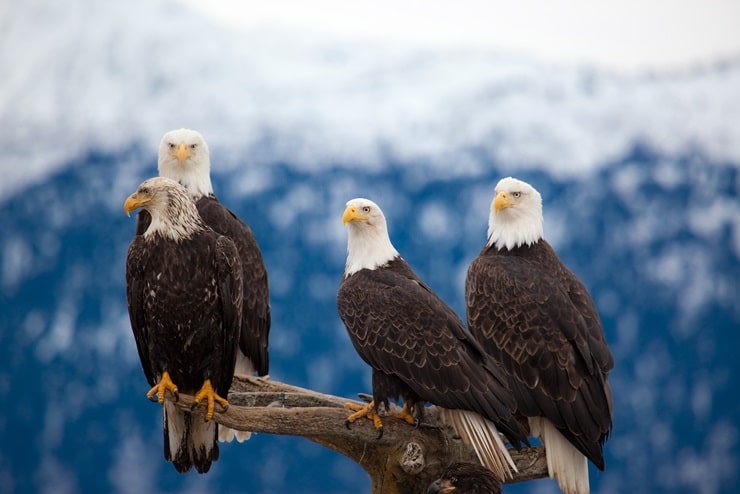Eagles are bird species within the family Accipitridae, which contain a collection of genera comprised of large raptors. Around 60 species of eagles are found on every continent except Antarctica, in the tundra, deserts, and tropical climates. These large birds fiercely hunt their prey, sometimes successfully capturing larger animals than themselves.
Because of their reputation as powerful hunters, eagles have served as a symbol to civilizations throughout history. Images of eagles adorn flags, money, and art worldwide. Classical literature from many different cultures references these birds throughout ancient texts and manuscripts.
Table of Contents
What is a Group of Eagles Called?
Eagles are typically solitary birds and do not flock together with unrelated eagles. They do, however, mate for life. These monogamous eagles raise their young together, a process that can take several years, depending on the species.
Thus, when people see groups of eagles congregating together, they are often within the same family group, consisting of two adults and multiple juveniles. These groups of eagles are usually referred to as “a Convocation” or “an Aerie”.

Other collective nouns for eagles
- Soar
- Colony
- Flock
- Flame
- Jubilee
- Stooping
- Spread
- Tower
The context, eagle species, language or dialect used, and country of origin all contribute to the collective noun used to describe a group of eagles.
Because of the increased urbanization all over the world, many species of eagles are at risk of extinction. Scientists on every continent study the adaptations that eagles have made to their nesting practices and prey selection based on their changing environment.
A South African study of African Crowned Eagles showed that convocations of eagles are at risk in these urban environments. Human-caused mortality occurs when an eagle family’s nest fails or the immature eagles begin preying on people’s pets.
What is a Group of Baby Eagles Called?
Eagles nest in the tallest, least accessible trees. Mating pairs of eagles exhibit high nest fidelity, returning to the same nesting location year after year. They only produce one or two chicks, rarely three, per year.
These groups of chicks, usually called eaglets or nestlings, eventually fledge. In three or four years, they slowly mature into adults. Groups of juveniles, commonly referred to as simply juveniles, usually stay close to their nest during the years while they mature.
Conservation of eagle species around the world is ongoing. Researchers combat the effects of urbanization by increasing their understanding of how eagles adapt to the changing environment.
Urban planners and landscape developers continue working with raptor biologists to mitigate environmental changes. With an increased interest by average citizens to protect these impressive birds, government officials are listening.
Also Read: Do Eagles Eat Snakes
Do Eagles Migrate?
Most eagle species are not, by nature, migratory birds. As long as the urban convocations of these eagles can find adequate food and nesting sites in their home location, they will raise successful clutches of eaglets each year.
The species of eagles that live outside urban areas in the northern climes do have to migrate further south in the winter. Eagles that hunt for food in the water need to fly further south to find food since many northern waters freeze over in winter, making fish inaccessible.
In migrating populations of eagles, juveniles do not migrate with their parents. Instead, these individuals fly to southern territories earlier in search of adequate food sources.
Overall, the migrating routes and strategies of most migratory eagle species are a mystery to researchers.
While eagle migration is not well understood, researchers study it worldwide. Scientists need to know which migration routes to protect and which overwintering locations to conserve.
Protecting these habitats is necessary for the continued survival of the world’s eagles.
